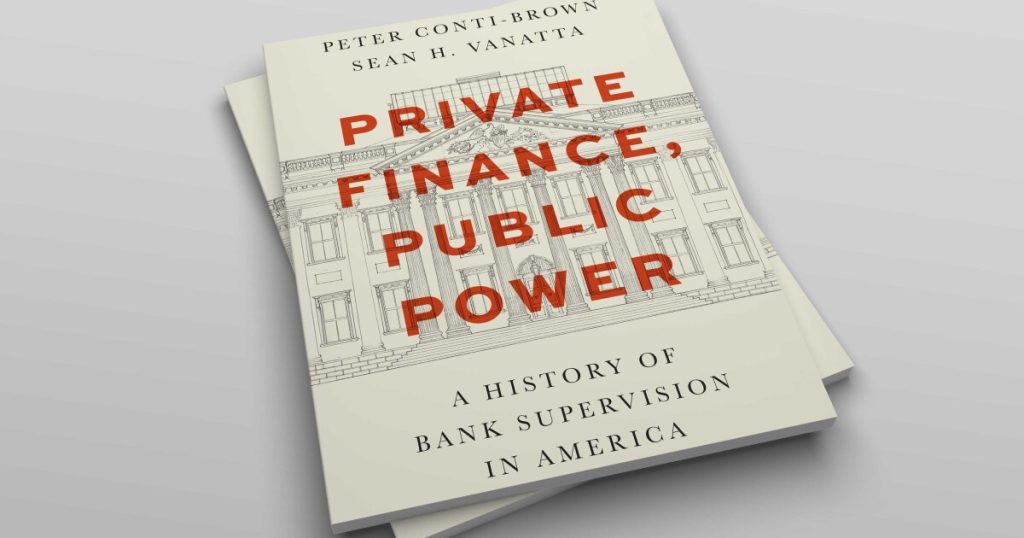Private Finance, Public Power: A History of Bank Supervision in America
By Peter Conti-Brown and Sean H. Vanatta
When the pandemic struck the U.S. economy in 2020, the Federal Reserve’s response was famously swift and expansive. From March to July 2020, it grew its balance sheet from $4 trillion to $7 trillion. In addition to large-scale purchases of government securities, the Fed provided liquidity directly to municipalities and businesses small and large. This kitchen-sink approach was likely necessary for the Fed to have any hope of meeting its statutory objectives to keep the economy on an even keel. Yet, it also made the Fed and its money-printing ability a cultural vector — epitomized by the virtual institutionalization of the “money printer go brr” meme. Despite all this, the Fed is still not the main printer of U.S. money — the private banking system is.
While the Fed’s “Main Street” lending facility infamously lent only $17 billion by the end of 2020, private banks executed $500 billion of new business loans in March 2020 alone. With markets ground to a halt, where did banks get this money to hand out? They manufactured it with a few keystrokes — creating a deposit in the borrower’s name — the same way the Fed does. Well wait, why don’t all firms simply perform this magic for themselves ad infinitum? It’s simple: only banks can.
Being a bank isn’t just a business-model choice, it requires the government to endow you with a charter, effectively contracting you to do the economy’s money printing. After all, we’ve collectively decided we (generally) want private actors deciding which firms get loans. And yet, manufacturing money is very much a public function and requires that public interest remain in the room. That is, banks require special supervision, and the “who,” “how” and “how much” of bank supervision are not just financial history but American history. Bank supervisors’ “responsibility is a cornerstone of modern finance,” write Peter Conti-Brown and Sean H. Vanatta. “The truth is that the system of banking in the United States is a story of private finance, backed inescapably by public power.”
Conti-Brown and Vanatta, through deep historical research and tales of key individuals, chart the U.S.’s bank supervisory pendulum from the Constitution through the 1970s. It’s a story of competing theories of capitalism, banking and risk management that is essential reading for the modern moment. As a wave of new bank regulators descends on Washington less than two years after three historic bank failures, bank supervision is at a pivotal moment. “Private Finance, Public Power” holds countless insights for bank supervision stakeholders to at least only make new mistakes.
When the book starts, prior to the Civil War, hand-to-hand currency was bank-specific. Rather than having the U.S. government’s full faith and credit, a banknote would have a specific bank promising to redeem the note in gold. The constant threat of redemption from nervous noteholders forced banks to limit their credit and liquidity risk, keeping high gold reserves on hand — in other words, doing less banking. This may sound familiar to bankers who have felt supervision swing toward an expectation of higher bank self-insurance in the aftermath of the bank runs of 2023.
As Conti-Brown and Vanatta write, states predictably were soon “searching for something that permitted growth while managing stability, something less rigidly wedded to fixed rules and more permissive of a balanced approach. Enter the bank examiner, the first public instance of the institutionalized discretionary approach to bank supervision.” Such supervision was alternately viewed as a costly state intrusion and something that even bank shareholders should favor, as a supervisory stamp of approval brought with it customer confidence and more business for the bank. If this sounds familiar, it’s probably because it echoes in today’s debates over capital requirements: Do higher capital requirements impose unnecessary costs on banks or bolster perceptions of their reliability at home and abroad?
“Private Finance, Public Power” documents 180 years of the trials and tribulations of impressive (and unimpressive) bank supervisors —and their congressional, presidential, and judicial overseers — trying to answer the question, “What, exactly, were these new officials supposed to do in their examinations? Perform an audit? Look for fraud?” What is the right balance of supervisors functioning as consultants versus police officers? Advisors versus inspection officers? This question remains not only unanswered, but at the center of policymakers’ minds today.
Outgoing Fed Vice Chair for Supervision Michael Barr, a Democratic appointee, led the Fed’s
Republicans, including many of the incoming crop of regulators, have meanwhile criticized a supervisory overreach into areas immaterial to bank safety and soundness — which they say distracted from material financial risks left unaddressed in plain sight. Including the other agencies offers a mixed assessment: The Federal Deposit Insurance Corporation and the New York Department of Financial Services offered
With a Republican sweep of Washington, D.C., it’s clear the pendulum is going to swing again. Conti-Brown and Vanatta’s book doesn’t suggest the pendulum shouldn’t keep swinging. As they write, “because bank supervision is the institutionalized management of residual risk, we should see changes — and should want to see changes — in risk tolerance that follow electoral cycles, the highest form of accountability available in a democracy.” Yet, their charting of history offers a roadmap to at least building on the extreme swings of the past — and to swing more narrowly into the future.
Steven Kelly is the associate director of research, Yale Program on Financial Stability, Yale School of Management.

